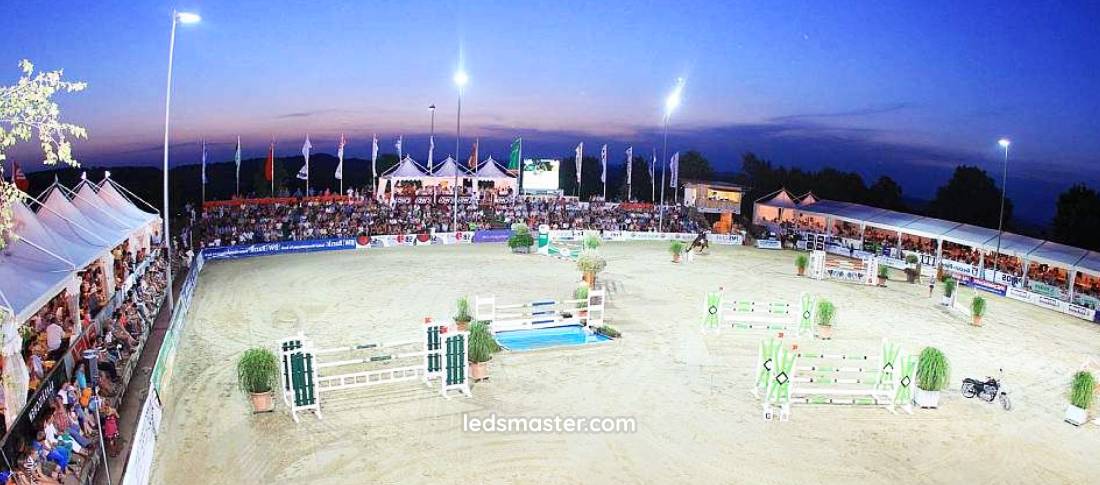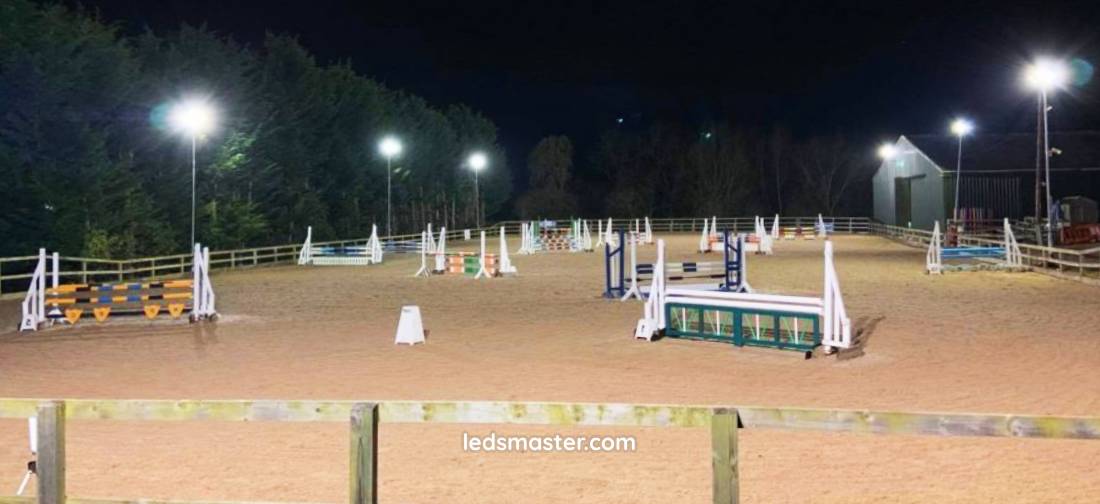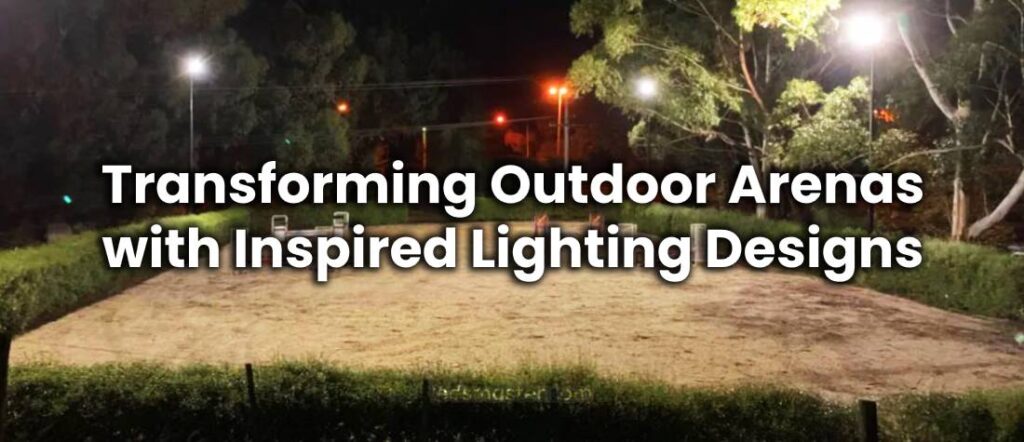The right lighting design can enhance the experience of both riders and horses, providing a safe and efficient environment for various equestrian activities. Understanding what designs are available, how to approach the design process, and why proper lighting is required ensures that outdoor arenas are not only visually appealing but also optimized for performance and safety.
Table of Contents
ToggleWhat Designs Are Available for Outdoor Horse Arena Lighting?
Traditional Lighting Systems
Traditional lighting systems for outdoor horse arenas often include high-intensity discharge (HID) lights, such as metal halide or high-pressure sodium lamps. These lights have been a go-to option for many years due to their ability to produce bright, wide-reaching illumination. However, while they offer good light distribution, these systems can sometimes have drawbacks, such as slower start-up times and higher energy consumption. Even though traditional lighting works, newer innovations have emerged to improve energy efficiency and overall quality.
HID lights, like metal halide, provide bright white light, which is ideal for large outdoor spaces. However, they tend to generate a lot of heat and can require time to reach full brightness, which can be inconvenient in situations where lighting is needed immediately. Furthermore, their energy consumption and short lifespan in comparison to newer technologies like LED and solar-powered systems are becoming more of a concern in today’s environmentally conscious society. Still, HID lights continue to be used in many outdoor settings due to their cost-effectiveness in the short term and ability to provide broad illumination.
LED Lighting Systems

LED lighting has become a popular option for modern outdoor horse arena lighting. These systems are energy-efficient, offering the same bright illumination as traditional lights but with much lower energy consumption. LEDs also provide longer lifespans, meaning they require less maintenance and are more cost-effective over time. The ability to dim LED lights is another advantage, allowing for tailored lighting levels based on the specific needs of the event or training session.
LED lights have revolutionized the lighting industry with their energy efficiency, long life span, and low maintenance costs. As technology has advanced, LED lights have become much more affordable, making them a viable option for outdoor horse arenas. LED systems not only deliver bright, white light that improves visibility but also significantly reduce the arena’s electricity bills due to their low energy consumption. Furthermore, because they are available in a variety of color temperatures, LEDs can provide a lighting ambiance that matches the activity at hand, whether it is training or competition.
Solar-Powered Lighting
For those looking for an environmentally friendly and cost-saving alternative, solar-powered lighting systems provide a viable solution. Solar-powered lights capture energy from the sun during the day and store it in batteries to be used for lighting in the evening. While this system can be highly effective in locations with ample sunlight, it might not always be sufficient for areas with less sun exposure. However, advancements in solar technology are making it an increasingly reliable option for outdoor horse arena lighting.
Solar-powered lighting systems are an excellent way to reduce the environmental impact of outdoor horse arenas. These systems can be particularly useful in remote areas where connecting to the electrical grid might be difficult or expensive. The use of solar energy to power lighting systems helps reduce reliance on fossil fuels, making it a sustainable choice. However, while solar-powered lighting is cost-effective and eco-friendly, it does require careful planning regarding battery storage and sun exposure to ensure the lights will function optimally throughout the year.
Floodlights and Spotlights
For arenas used for competitions or events, floodlights and spotlights can be designed into the lighting system to focus on specific areas. Floodlights are ideal for illuminating large sections of the arena, ensuring that the entire space is well-lit. Spotlights, on the other hand, are used to highlight particular areas of the arena, such as jumps or specific riding segments. Both types of lighting allow for adjustable brightness and coverage, ensuring that every performance is clearly visible.
Floodlights are commonly used to provide overall illumination in larger outdoor arenas. These fixtures are designed to cast a wide beam of light, covering extensive areas of space. Spotlights, on the other hand, provide focused beams of light, which can be used to highlight specific areas such as horse jumps, dressage arenas, or other focal points. The use of floodlights and spotlights together creates a well-lit environment that improves safety and enhances performance, making it easier for both participants and spectators to see every detail of the event.
Smart Lighting Systems
With advancements in technology, smart lighting systems are becoming more common in outdoor arenas. These systems use sensors and automated controls to adjust lighting based on factors like the time of day or weather conditions. Smart lights can be integrated with other systems in the arena, such as cameras or security systems, to provide a comprehensive solution for lighting management. These systems allow for enhanced customization, energy efficiency, and remote management.
Smart lighting is a game-changer in the world of outdoor arena design. These systems can be programmed to automatically adjust based on natural light levels or preset schedules. For example, as the sun sets, the lights can automatically brighten, ensuring that the arena remains well-lit throughout the evening. Smart systems also allow for real-time adjustments, which is particularly useful during events or competitions. By offering flexibility, energy savings, and automation, smart lighting provides a modern solution for those seeking to optimize their outdoor horse arena.

How to Design an Outdoor Horse Arena Lighting System?
Assessing the Size and Layout of the Arena
Before selecting a lighting design, it’s important to understand the size and layout of the outdoor horse arena. Larger arenas may require more lights or more powerful systems to ensure uniform coverage, while smaller arenas may only need fewer lights placed strategically. The layout, including the presence of obstacles like jumps or arenas with varying levels of elevation, will also affect the design. Proper lighting needs to be able to illuminate all areas where riders and horses will be performing, ensuring that there are no dark spots that could pose a safety hazard.
The size and layout of the arena directly influence the number of fixtures required and how they are spaced out. A rectangular arena, for example, might need lights placed along the long sides of the perimeter, while a circular arena could benefit from lights positioned along its circumference. The lighting system needs to be designed to cover all corners of the arena, including any elevated platforms or jumps. Taking the layout into account ensures that the light distribution is consistent and effective.
Determining the Purpose and Type of Activities
The type of activities taking place in the arena will influence the design choices. For instance, an arena used for dressage or training might not require as much focused light as one used for show jumping or competitions. Understanding the purpose of the arena allows designers to tailor the lighting for specific events, ensuring optimal visibility for riders, horses, and spectators. In some cases, high-intensity lights may be necessary for nighttime events, while softer, more diffused light might be adequate for everyday training.
Different activities have varying lighting needs. High-precision sports like dressage require uniform and steady lighting, as even slight variations can affect the performance. In contrast, activities like jumping or rodeo events may benefit from brighter, more focused lighting to highlight certain areas of the arena. By considering the type of events and training that will take place, the lighting system can be designed to accommodate these needs, ensuring a balanced and effective illumination throughout.
Selecting the Right Type of Lighting
Once the size, layout, and purpose of the arena have been assessed, choosing the right type of lighting is the next step. For most outdoor arenas, a combination of floodlights and spotlights will be needed. Floodlights provide general illumination, while spotlights can be used to highlight specific areas of interest. It’s also necessary to select fixtures that can withstand outdoor conditions, such as rain, wind, and dirt. Weatherproof, durable lights will ensure long-lasting functionality and safety for the arena.
Selecting the appropriate lighting fixture involves understanding the weather conditions the arena is exposed to, as lights must be able to function well in various elements. Weatherproof fixtures are necessary to withstand rain, snow, and extreme temperatures. Additionally, the color temperature of the lighting is important; cooler temperatures tend to mimic daylight, which is ideal for activities that require clear, precise visibility.
Placement of Lights
The placement of lights within the arena is one of the most important aspects of the design. Lights should be arranged so that they evenly distribute light across the entire area without causing glare or shadows. Typically, poles are placed at the perimeter of the arena, with additional lights positioned strategically over the riding surface. The height of the light poles is also an important consideration, as higher poles can help minimize shadows and create more even lighting.
Proper light placement is key to ensuring that the entire arena is illuminated without areas of darkness or overexposure. Pole height should be considered to avoid shadows that may obscure the riders’ visibility and cause distractions. Typically, lighting poles should be spaced strategically to achieve uniform coverage without any dark spots or excessive light.
Controlling Light Levels
Depending on the time of day and the type of activity, it may be necessary to adjust the light levels within the arena. Automated dimming systems can be integrated into the design to adjust the lighting based on natural daylight conditions or specific needs for each event. For example, during competitions, bright lights may be necessary to ensure clear visibility for spectators and judges, while lower lighting may suffice during training sessions.
Lighting controls should allow for flexibility to adjust the intensity of the lights according to the specific needs of the event or training session. Dimming systems can help optimize the lighting for both daytime and evening conditions. By managing light intensity, energy consumption is minimized, and the lighting can be adapted to different activities.
Choosing Energy-Efficient Solutions
Energy efficiency is a growing concern in outdoor lighting design. LED systems are often the preferred choice for outdoor arenas because of their low energy consumption and long lifespan. Additionally, incorporating solar-powered lights into the design can further reduce energy costs and the environmental impact of the arena. Not only will energy-efficient lighting lower electricity bills, but it also supports sustainable practices by minimizing the carbon footprint of the arena.
Energy-efficient lighting reduces operating costs and supports the move toward more sustainable solutions. The adoption of LEDs and solar-powered lights reflects a commitment to eco-friendly practices. These systems use less energy while providing optimal lighting, helping reduce the carbon footprint of outdoor arenas.
Why Is Proper Outdoor Arena Lighting Needed?
Enhancing Safety and Visibility
Proper lighting ensures that riders and horses can see clearly and be seen by others, which is essential for safety. Outdoor horse arenas can become dangerous if riders cannot see potential obstacles or hazards due to poor lighting. Horses, in particular, are sensitive to their environment, and inadequate lighting may cause them to become disoriented or stressed, increasing the risk of accidents. By providing sufficient light, both riders and horses can move with confidence, reducing the likelihood of injury.
Good visibility not only increases safety by minimizing the risk of accidents but also enables riders to perform at their best. Adequate lighting ensures that obstacles and jumps are clearly visible, preventing accidents that might otherwise occur due to insufficient lighting.
Supporting Equestrian Performance
For equestrian performances, good lighting helps showcase the skills of the rider and the horse. Events like dressage, show jumping, and other competitions require precise movements that need to be clearly visible to judges, spectators, and the participants themselves. Proper lighting highlights the precision and fluidity of each movement, allowing for an accurate assessment of performance. Additionally, well-lit arenas create a professional atmosphere for events, enhancing the overall experience.
Lighting is a vital part of equestrian performances. It not only ensures that the audience can clearly see the movements but also helps judges assess the performance accurately. The right lighting highlights both the horse and rider, making their movements stand out for a better viewing experience.
Extending the Use of the Arena
With the right lighting design, an outdoor horse arena can be used for longer hours, even into the evening or night. This is especially beneficial for training or events during the winter months, when daylight hours are shorter. Well-lit arenas allow riders to continue their training without being limited by natural light, offering more flexibility in scheduling. By extending the use of the arena, riders and trainers can make the most of their time and resources.
The ability to extend the use of the arena well into the evening allows for more flexible scheduling of training and events. It ensures that the arena is usable throughout the year, regardless of daylight hours.
Reducing Glare and Shadows
Glare and shadows can be a major issue in outdoor horse arenas, especially when the lighting is poorly designed. Glare can cause visual discomfort, while shadows can create dangerous blind spots that obstruct visibility. Properly designed lighting systems, with well-placed lights at the correct angles, help to minimize these problems. The goal is to create an environment where light is evenly distributed across the entire arena, ensuring that both riders and horses have a clear line of sight at all times.
Proper light placement and distribution prevent glare and shadows from becoming issues that impair the performance of both riders and
horses. Carefully designed systems ensure visibility across all areas of the arena without visual discomfort.
Environmental and Aesthetic Considerations
In addition to functional benefits, lighting design can enhance the overall look and feel of the outdoor arena. Thoughtfully designed lighting systems can create an inviting atmosphere, adding to the beauty of the arena and surrounding landscape. For venues that host competitions or events, visually appealing lighting contributes to the overall experience, making the arena more attractive to both participants and spectators. Lighting can also be used to highlight certain architectural features or landscape elements, adding to the visual appeal.
Beyond functionality, good lighting can enhance the visual appeal of the arena, creating an inviting atmosphere for both participants and spectators. Thoughtful designs can highlight features of the surrounding landscape or the architecture of the arena, improving its aesthetic value.
Conclusion
Different types of lighting systems, including traditional, LED, and solar-powered lights, offer various benefits depending on the specific needs of the arena. A well-designed system takes into account the size and layout of the arena, the activities taking place, and the environmental conditions. The placement of lights, their energy efficiency, and the ability to adjust light levels all contribute to creating an optimal riding environment. With the right lighting, outdoor arenas become safer, more functional, and visually appealing spaces for both riders and horses.

